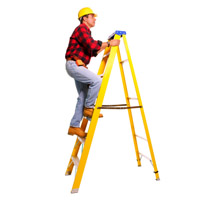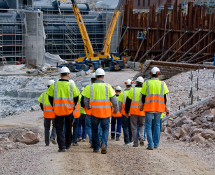Stairways and ladders are a major source of injuries and fatalities among construction workers. OSHA estimates that there are 24,882 injuries and as many as 36 fatalities per year due to falls from stairways and ladders used in construction. Nearly half of these injuries are serious enough to require time off the job–11,570 lost workday injuries and 13,312 non-lost workday injuries occur annually due to falls from stairways and ladders used in construction.
Stairways:
The stairway to a second or higher floor shall be completed before studs are raised to support the next higher floor • Even temporary stairways shall have landings of not less than 30″ in the direction of travel and extend at least 22″ in width at every 12′ or less of vertical rise • Stairs shall be installed between 30° and 50° from horizontal. • Stairways, ramps or ladders shall be provided at all points where a break in elevation of 18″ or more occurs in a frequently traveled passage way, entry or exit • Ramps used for access must be 18″ wide and no steeper than a 20° angle. • Cleats shall not be nailed to studs to provide access to and egress from roofs or other work areas. • Variations in riser height or tread depth shall not be over 1/4″ • Where doors or gates open directly on a stairway, a platform shall be provided, and the swing of the door shall not reduce the elective width of the platform to less than 20” • Slippery conditions on stairways shall be eliminated before the stairways are used to reach other levels • Stairways having four or more risers or rising more than 30″, whichever is less, need at least one handrail (not more than 37″ nor less than 36″ from the upper surface) capable of withstanding a force of 200 lbs; and one stair rail system along each open side • Mid-rails, screens, or mesh, shall be provided between the top rail of the stair rail system and the stairway steps. When intermediate vertical members, such as balusters, are used between posts, they shall be not more than 19″ apart • Stair rail systems and handrails shall be surfaced as to prevent punctures or lacerations, and to prevent snagging of clothing.
Misuse of Portable Ladders:
Am I In Danger?
You risk falling if portable ladders are not safely positioned each time they are used. While you are on a ladder, it may move and slip from its supports. You can also lose your balance while getting on or off an unsteady ladder. Falls from ladders can cause injuries ranging from sprains to death.
How Do I Avoid Hazards?
Position portable ladders so the side rails extend at least 3 feet above the landing.
Secure side rails at the top to a rigid support and use a grab device when 3 foot extension is not possible.
Make sure that the weight on the ladder will not cause it to slip off its support.
Before each use inspect ladders for cracked or broken parts such as rungs, steps, side rails, feet and locking components.
Do not apply more weight on the ladder than it is designed to support
Use only ladders that comply with OSHA design standards.
General Ladder Safety:
- Inspect before use for physical defects • Do not paint ladders except for numbering purposes • Do not use ladders for skids, braces, workbenches, or any purpose other than climbing • When you are ascending or descending a ladder, do not carry objects that will prevent you from grasping the ladder with both hands • Always face the ladder when ascending and descending • If you must place a ladder over a doorway, barricade the door to prevent its use and post a warning sign • Only one person is allowed on a ladder at a time • Do not jump from a ladder when descending • All joints between steps, rungs, and side rails must be tight • Safety feet must be in good working order and in place • Rungs must be free of grease and or oil • Labels must be original and weight loads must be followed for each class of ladder
Stepladders:
- Do not place tools or materials on the steps or platform of a stepladder • Do not use the top two steps of a stepladder as a step or stand • Always level all four feet and lock spreaders in place • Do not use a stepladder as a straight ladder
Straight type or extension ladders:
- All straight or extension ladders must extend at least 3′ beyond the supporting object when used as an access to an elevated work area •Extension ladders should be positioned at a 4:1 ratio from the building for proper climbing angle • After raising the extension portion of a two or more stage ladder to the desired height, check to ensure that the safety dogs or latches are engaged • All extension or straight ladders must be secured or tied o! at the top and bottom • All ladders must be equipped with safety (non-skid) feet.







Previously when working we were required to have the bottoms of extension ladders secured to a rigid object also, and when using a step ladder it was to be supported by a second individual. I didn’t see mention of this. Do these rules still apply or have they been modified recently? This was from several work sites with different companies, I believe it was more then a company policy.
Yes it is necessary to stabilize extension ladder to a rigid object. It is best practice to stabilize/secure both top and bottom of extension ladders when using as access and egress to an upper level.
It is not a requirement to have a person stabilizing a step ladder unless deemed necessary for that activity or as required by your company’s work site safety plan.